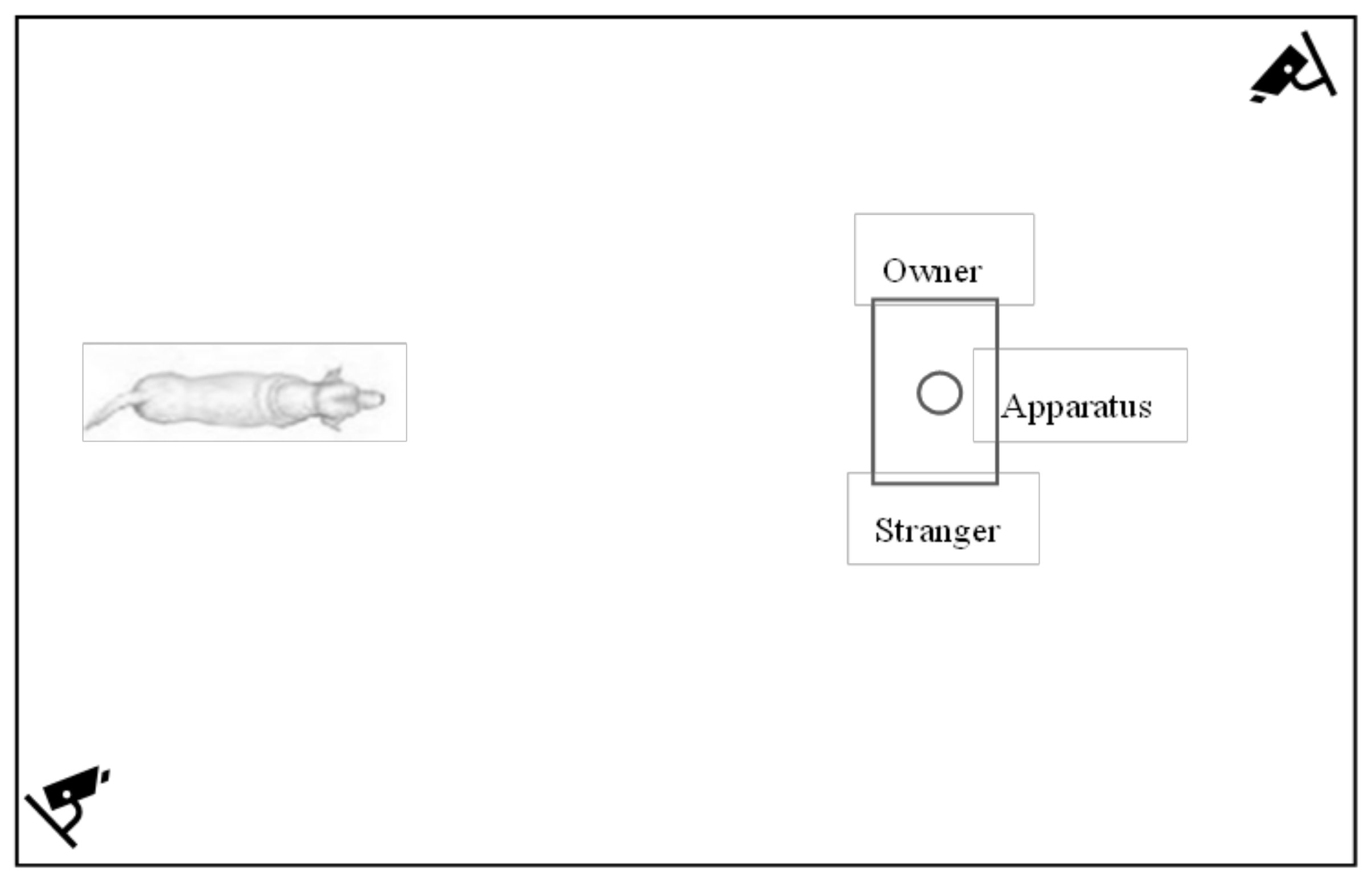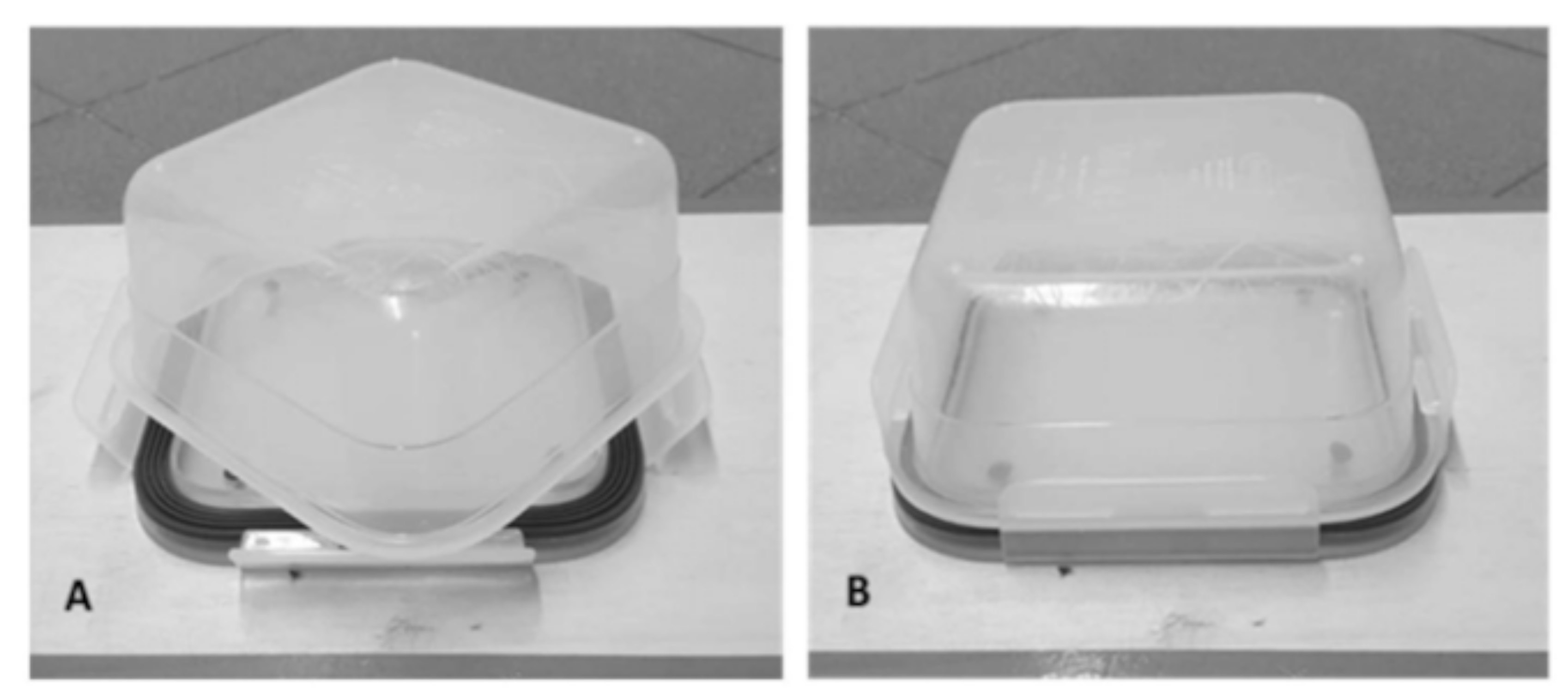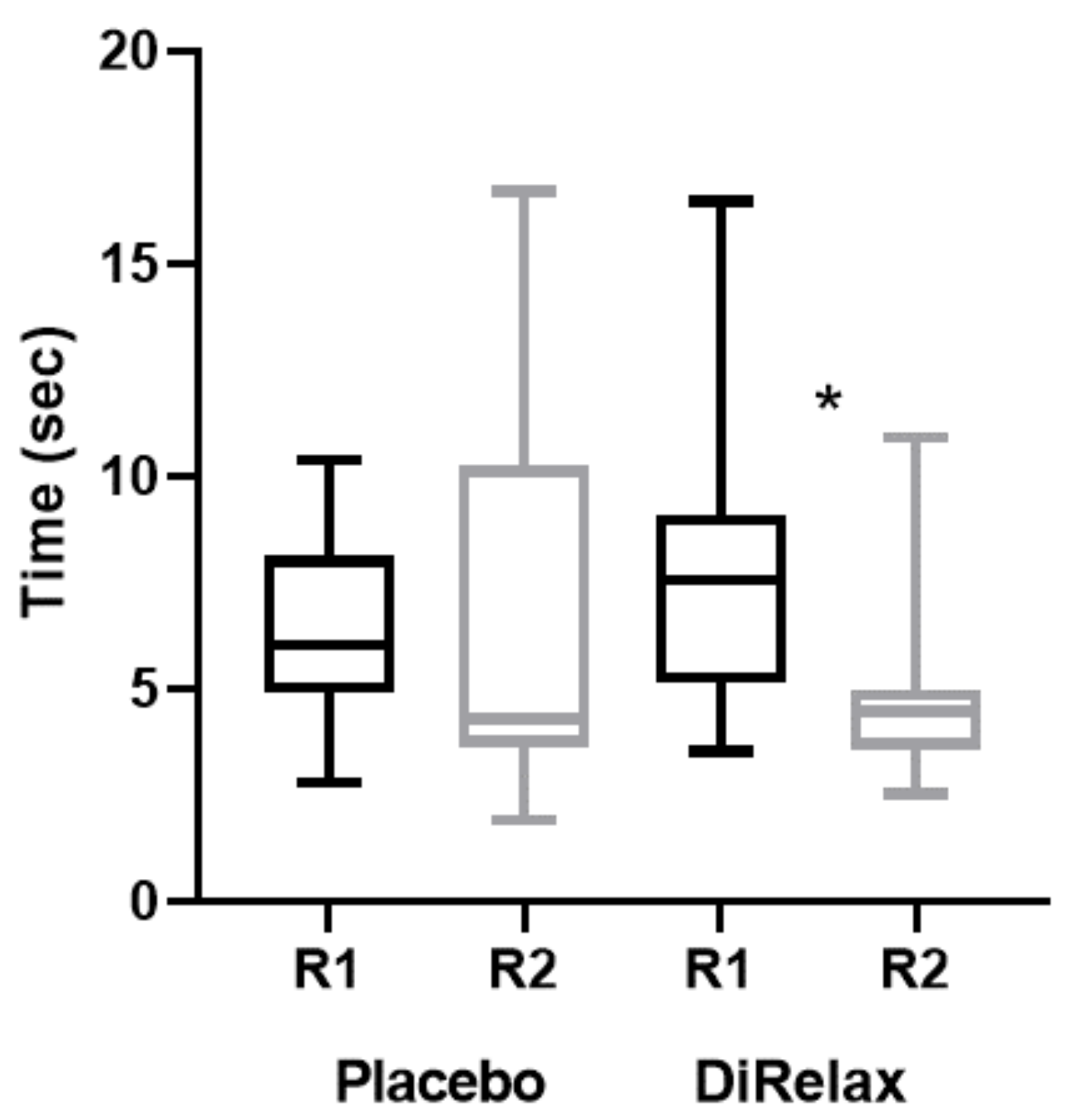Effects of a Nutritional Supplement (DìRelaxTM) on Anxiety in Dogs in a Randomized Control Trial Design
Abstract
:Simple Summary
Abstract
1. Introduction
2. Materials and Methods
2.1. Animals
2.2. Experimental Design
2.3. C-BARQ Questionnaire
2.4. Blood Analysis
2.5. Impossible Task Test
2.5.1. Experimental Setting
2.5.2. Procedure
2.5.3. Data Collection
2.6. Statistics
3. Results
3.1. Clinical Scores
3.2. Blood Analysis
3.3. Impossible Task Test
4. Discussion
4.1. Impossible Task Test
4.2. Blood Analysis
5. Limitations
6. Conclusions
Author Contributions
Funding
Institutional Review Board Statement
Informed Consent Statement
Data Availability Statement
Acknowledgments
Conflicts of Interest
References
- Overall, K.L. Clinical Behavioral Medicine for Small Animals; Mosby-Year Book Inc.: St. Louis, MO, USA, 1997; p. 0-80166-820-4. [Google Scholar]
- Glenk, L.M. Current Perspectives on Therapy Dog Welfare in Animal-Assisted Interventions. Animals 2017, 7, 7. [Google Scholar] [CrossRef] [PubMed]
- Ibáñez Talegón, M.; Anzola Delgado, B. Anxiety Disorders in Dogs. In Anxiety Disorders; Kalinin, V., Ed.; IntechOpen: London, UK, 2011. [Google Scholar] [CrossRef] [Green Version]
- Overall, K.L. Dogs as "natural" models of human psychiatric disorders: Assessing validity and understanding mechanism. Prog. Neuropsychopharmacol. Biol. Psychiatry 2000, 24, 727–776. [Google Scholar] [CrossRef]
- Sherman, B.; Mills, D. Canine Anxieties and Phobias: An Update on Separation Anxiety and Noise Aversions. Vet. Clin. North. Am. Small. Anim. Pract. 2008, 38, 1081–1106. [Google Scholar] [CrossRef] [PubMed]
- Notari, L.; Cannas, S.; Di Sotto, Y.A.; Palestrini, C. A Retrospective Analysis of Dog-Dog and Dog-Human Cases of Aggression in Northern Italy. Animals 2020, 10, 1662. [Google Scholar] [CrossRef]
- Flannigan, G.; Dodman, N.H. Risk factors and behaviors associated with separation anxiety in dogs. J. Am. Vet. Med. Assoc. 2001, 219, 460–466. [Google Scholar] [CrossRef] [Green Version]
- Pineda, S.; Anzola, B.; Ibáñez, M. Fluoxetine combined with clorazepate dipotassium and behaviour modification for treatment of anxiety-related disorders in dogs. Med. Vet. J. 2014, 199, 387–391. [Google Scholar] [CrossRef]
- Pero, M.E.; Cortese, L.; Mastellone, V.; Tudisco, R.; Musco, N.; Scandurra, A.; D’Aniello, B.; Vassalotti, G.; Bartolini, F.; Lombardi, P. Effects of a nutritional supplement on cognitive function in aged dogs and on synaptic function of primary cultured neurons. Animals 2019, 9, 393. [Google Scholar] [CrossRef] [Green Version]
- Rolland, A.; Fleurentin, J.; Lanhers, M.C.; Younos, C.; Misslin, R.; Mortier, F.; Pelt, J.M. Behavioural effects of the American traditional plant Eschscholzia californica: Sedative and anxiolytic properties. Planta Med. 1991, 57, 212–216. [Google Scholar] [CrossRef] [PubMed]
- Abdellah, S.A.; Berlin, A.; Blondeau, C.; Guinobert, I.; Guilbot, A.; Beck, M.; Duforez, F. A combination of Eschscholtzia californica Cham. and Valeriana officinalis L. extracts for adjustment insomnia: A prospective observational study. J. Tradit. Complement. Med. 2019, 10, 116–123. [Google Scholar] [CrossRef]
- Chadwick, L.R.; Pauli, G.F.; Farnsworth, N.R. The pharmacognosy of Humulus lupulus L. (hops) with an emphasis on estrogenic properties. Phytomedicine 2006, 13, 119–131. [Google Scholar] [CrossRef] [Green Version]
- Poojari, P.; Kiran, K.R.; Swathy, P.S.; Muthusamy, A. Withania somnifera (L.) Dunal: An Overview of Bioactive Molecules, Medicinal Properties and Enhancement of Bioactive Molecules Through Breeding Strategies. In In Vitro Plant Breeding towards Novel Agronomic Traits; Kumar, M., Muthusamy, A., Kumar, V., Bhalla-Sarin, N., Eds.; Springer: Singapore, 2019. [Google Scholar]
- Soulimani, R.; Younos, C.; Jarmouni, S.; Bousta, D.; Misslin, R.; Mortier, F. Behavioural effects of Passiflora incarnata L. and its indole alkaloid and flavonoid derivatives and maltol in the mouse. J. Ethnopharmacol. 1997, 57, 11–20. [Google Scholar] [CrossRef]
- Wibrand, K.; Berge, K.; Messaoudi, M.; Duffaud, A.; Panja, D.; Bramham, C.R.; Burri, L. Enhanced cognitive function and antidepressant-like effects after krill oil supplementation in rats. Lipids Health Dis. 2013, 12, 6. [Google Scholar] [CrossRef] [PubMed] [Green Version]
- Gamoh, S.; Hashimoto, M.; Sugioka, K.; Shahdat Hossain, M.; Hata, N.; Misawa, Y.; Masumura, S. Chronic administration of docosahexaenoic acid improves reference memory-related learning ability in young rats. Neuroscience 1999, 93, 237–241. [Google Scholar] [CrossRef]
- Hsu, Y.; Serpell, J.A. Development and validation of a questionnaire for measuring behavior and temperament traits in pet dogs. J. Am. Vet. Med. Assoc. 2003, 223, 1293–1300. [Google Scholar] [CrossRef] [PubMed] [Green Version]
- D’Aniello, B.; Scandurra, A. Impossible task paradigm. In Encyclopedia of Animal Cognition and Behavior; Vonk, J., Shackelford, T., Eds.; Springer International Publishing: Berlin/Heidelberg, Germany, 2017. [Google Scholar]
- Miklósi, Å.; Kubinyi, E.; Topál, J.; Gácsi, M.; Virányi, Z.; Csányi, V. A simple reason for a big difference: Wolves do not look back at humans, but dogs do. Curr. Biol. 2003, 13, 763–766. [Google Scholar] [CrossRef] [Green Version]
- D’Aniello, B.; Scandurra, A.; Prato-Previde, E.; Valsecchi, P. Gazing toward humans: A study on water rescue dogs using the impossible task paradigm. Behav. Process. 2015, 110, 68–73. [Google Scholar] [CrossRef]
- Scandurra, A.; Prato-Previde, E.; Valsecchi, P.; Aria, M.; D’Aniello, B. Guide dogs as a model for investigating the effect of life experience and training on gazing behaviour. Anim. Cogn. 2015, 18, 937–944. [Google Scholar] [CrossRef] [Green Version]
- Passalacqua, C.; Marshall-Pescini, S.; Merola, I.; Palestrini, C.; Prato-Previde, E. Different problem-solving strategies in dogs diagnosed with anxiety-disorders and control dogs in an unsolvable task paradigm. Appl. Anim. Behav. Sci. 2013, 147, 139–148. [Google Scholar] [CrossRef]
- Duffy, D.L.; Kruger, K.A.; Serpell, J.A. Evaluation of a behavioral assessment tool for dogs relinquished to shelters. Prev. Vet Med. 2014, 117, 601–609. [Google Scholar] [CrossRef]
- Clive, D.L. Wynne. The Indispensable Dog. Front. Psychol. 2021, 12, 656529. [Google Scholar] [CrossRef]
- Overall, K.L. That dog is smarter than you know: Advances in understanding canine learning, memory, and cognition. Top Companion Anim. Med. 2011, 26, 2–9. [Google Scholar] [CrossRef] [Green Version]
- Rault, J.L.; Waiblinger, S.; Boivin, X.; Hemsworth, P. The Power of a Positive Human-Animal Relationship for Animal Welfare. Front. Vet. Sci. 2020, 7, 590867. [Google Scholar] [CrossRef] [PubMed]
- Elgier, A.M.; Jakovcevic, A.; Barrera, G.; Mustaca, A.E.; Bentosela, M. Communication between domestic dogs (Canis familiaris) and humans: Dogs are good learners. Behav. Processes 2009, 81, 402–408. [Google Scholar] [CrossRef] [PubMed]
- Horwitz, D. Blackwell’s Five-Minute Veterinary Consult. Clinical Companion. Canine and Feline Behaviour, 2nd ed.; Horwitz, D., Ed.; John Wiley & Sons, Inc.: Ames, IA, USA, 2017; pp. 259–262. [Google Scholar]
- Lombardi, P.; Palatucci, A.T.; Giovazzino, A.; Mastellone, V.; Ruggiero, G.; Rubino, V.; Musco, N.; Crupi, R.; Cutrignelli, M.I.; Britti, D.; et al. Clinical and Immunological Response in Dogs Naturally Infected by L. infantum Treated with a Nutritional Supplement. Animals 2019, 9, 501. [Google Scholar] [CrossRef] [PubMed] [Green Version]
- Mastellone, V.; Musco, N.; Vassalotti, G.; Piantedosi, D.; Vastolo, A.; Cutrignelli, M.I.; Britti, D.; Cortese, L.; Lombardi, P. A Nutritional Supplement (DìLshTM) Improves the Inflammatory Cytokines Response, Oxidative Stress Markers and Clinical Signs in Dogs Naturally Infected by Leishmania infantum. Animals 2020, 10, 938. [Google Scholar] [CrossRef] [PubMed]
- Dalgleish, T.; Taghavi, R.; Neshat-Doost, H.; Moradi, A.; Canterbury, R.; Yule, M. Patterns of processing bias for emotional information across clinical disorders: A comparison of attention, memory, and prospective cognition in children and adolescent with depression, generalized anxiety, and post-traumatic stress disorders. J. Clin. Child. Psychol. 2003, 32, 10–21. [Google Scholar] [CrossRef]
- McNaughton, N. Cognitive dysfunction resulting from hippocampal hyperactivity—A possible cause of anxiety disorder? Pharmacol. Biochem. Behav. 1997, 56, 603–611. [Google Scholar] [CrossRef]



| Name | Age (Years) | Breed | Weight (Kg) | Sex | Neutered | Treatment |
|---|---|---|---|---|---|---|
| Zikri | 7 | Mixed | 9.1 | Female | Yes | Placebo |
| Toki | 2 | Pitbull | 25 | Male | No | Placebo |
| Cliff | 7 | Poodle | 9 | Male | Yes | Placebo |
| Kiko | 6 | Shiba-inu | 14.5 | Male | No | Placebo |
| Marek | 15 | Beagle | 15 | Male | No | Placebo |
| Flora | 11 | Yorkshire | 3.5 | Female | No | Placebo |
| Molly | 6 | Jack Russel | 5.5 | Female | Yes | Placebo |
| Nate | 3 | Mixed | 20 | Male | No | Placebo |
| Baby | 1 | Mixed | 8.6 | Female | No | Supplement |
| Maya | 3 | Cocker spaniel | 15 | Female | No | Supplement |
| Laika | 13 | Mixed | 19 | Female | Yes | Supplement |
| Renè | 2 | Italian wolf | 25 | Male | No | Supplement |
| Wilma | 7 | Jack Russel | 7.8 | Female | Yes | Supplement |
| Rudy | 2 | Mixed | 16 | Male | Yes | Supplement |
| Luna | 2 | Mixed | 8 | Female | Yes | Supplement |
| Jack | 7 | Golden retriever | 41 | Male | No | Supplement |
| Joe | 1 | Golden retriever | 17 | Male | No | Supplement |
| Nerone | 1 | Mixed | 7.5 | Male | No | Supplement |
| Leo | 2 | Poodle | 3 | Male | No | Supplement |
| Olivia | 6 | Mixed | 7 | Female | No | Supplement |
| Maggie | 6 | Mixed | 9 | Female | No | Supplement |
| Target | Behavior | Description |
|---|---|---|
| Apparatus, Owner, Stranger | Gaze | Look at the target from a stationary position |
| Interact | Physical interaction with the target | |
| Towards | Go toward the target |
| Section | Question | p |
|---|---|---|
| Aggression | When his/her feed is taken away by a household member | 0.004 |
| Aggression | When approached while eating by another (familiar) household dog | 0.050 |
| Aggression | When barked, growled, or lunged at by an unfamiliar dog | 0.023 |
| Fear and anxiety | When groomed or bathed by a household member | 0.010 |
| Attachment and attention-seeking | Tends to follow you (or other members of the household) about the house, from room to room | 0.024 |
| Miscellaneous problems | Urinates when left alone at night or during the daytime | <0.001 |
| HCT | HB | RBC | WBC | PLT | TP | UREA | CREA | GLU | ALT | BIL | ALP | CHOL | TRI | |
|---|---|---|---|---|---|---|---|---|---|---|---|---|---|---|
| % | g/dL | 106/µL | 103/µL | 103/µL | g/dL | mg/dL | mg/dL | mg/dL | U/L | mg/dL | U/L | mg/dL | mg/dL | |
| Placebo | 50.16 | 17.19 | 7.185 | 11.11 | 287.67 | 6.42 | 33.62 | 1.32 | 79.93 | 35.12 | 0.200 | 92.94 | 171.62 | 64.06 |
| DìRelaxTM | 47.02 | 16.32 | 6.847 | 10.12 | 255.54 | 6.50 | 35.77 | 1.12 | 74.53 | 38.27 | 0.209 | 72.04 | 185.73 | 55.11 |
| Group effect p | 0.083 | 0.220 | 0.078 | 0.412 | 0.079 | 0.767 | 0.267 | 0.140 | 0.153 | 0.408 | 0.760 | 0.056 | 0.239 | 0.111 |
| Time effect p | 0.238 | 0.222 | 0.177 | 0.600 | 0.573 | 0.452 | 0.959 | 0.227 | 0.366 | 0.402 | 0.711 | 0.839 | 0.833 | 0.340 |
| RMSE | 5.400 | 2.201 | 0.587 | 3.81 | 56.18 | 0.671 | 6.00 | 0.414 | 11.66 | 11.85 | 0.095 | 33.22 | 37.16 | 17.27 |
Publisher’s Note: MDPI stays neutral with regard to jurisdictional claims in published maps and institutional affiliations. |
© 2022 by the authors. Licensee MDPI, Basel, Switzerland. This article is an open access article distributed under the terms and conditions of the Creative Commons Attribution (CC BY) license (https://creativecommons.org/licenses/by/4.0/).
Share and Cite
Scandurra, A.; Mastellone, V.; Pero, M.E.; Musco, N.; Iommelli, P.; Di Lucrezia, A.; Malgeri, A.; Tudisco, R.; D’Aniello, B.; Cortese, L.; et al. Effects of a Nutritional Supplement (DìRelaxTM) on Anxiety in Dogs in a Randomized Control Trial Design. Animals 2022, 12, 435. https://doi.org/10.3390/ani12040435
Scandurra A, Mastellone V, Pero ME, Musco N, Iommelli P, Di Lucrezia A, Malgeri A, Tudisco R, D’Aniello B, Cortese L, et al. Effects of a Nutritional Supplement (DìRelaxTM) on Anxiety in Dogs in a Randomized Control Trial Design. Animals. 2022; 12(4):435. https://doi.org/10.3390/ani12040435
Chicago/Turabian StyleScandurra, Anna, Vincenzo Mastellone, Maria Elena Pero, Nadia Musco, Piera Iommelli, Alfredo Di Lucrezia, Andrea Malgeri, Raffaella Tudisco, Biagio D’Aniello, Laura Cortese, and et al. 2022. "Effects of a Nutritional Supplement (DìRelaxTM) on Anxiety in Dogs in a Randomized Control Trial Design" Animals 12, no. 4: 435. https://doi.org/10.3390/ani12040435
APA StyleScandurra, A., Mastellone, V., Pero, M. E., Musco, N., Iommelli, P., Di Lucrezia, A., Malgeri, A., Tudisco, R., D’Aniello, B., Cortese, L., & Lombardi, P. (2022). Effects of a Nutritional Supplement (DìRelaxTM) on Anxiety in Dogs in a Randomized Control Trial Design. Animals, 12(4), 435. https://doi.org/10.3390/ani12040435








